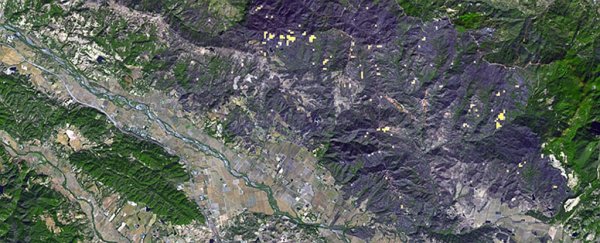The largest fire ever recorded in Sonoma County, California has spent nearly two weeks rampaging across the hills, burning everything in its path. So far, the Kincade Fire has burnt 77,758 acres of vegetation - and it's still raging.
Its scorched and blackened path has now been revealed in a new NASA satellite photo. On November 3, at 11:01 am Pacific Time, the Advanced Spaceborne Thermal Emission and Reflection Radiometer (ASTER) aboard the Terra satellite captured the below image of the damage.
That large region of dark grey running the entire length of the photo is the scar left behind by the fire.
It's speckled with yellow, pixellated dots - those are spots of heat in ASTER's view. In other words, that's where the fire still smoulders.
 (NASA/JPL-Caltech)
(NASA/JPL-Caltech)
It's reportedly the largest fire of the 2019 California fire season so far, although there's still a ways to go yet.
A report from the National Interagency Fire Center released last week warned that the season was likely to run through December due to drought conditions, with the rains predicted to be coming late this year.
It's also much smaller than last year's largest fire, the Mendocino Complex Fire that tore through 459,123 acres in July, August and September.
According to the California Department of Forestry & Fire Protection, in the 12 days the Kincade Fire has been burning, 374 structures - including residential and commercial buildings - have been destroyed and a further 60 have been damaged.
Only four people have been injured by the fire, however, and no fatalities have been reported.
At time of writing, the fire is estimated to be 86 percent under control, and the evacuation orders issued have been lifted. Some areas remain under evacuation standby, and the Sonoma County Health Officer has proclaimed a local health emergency and issued a Health Order which still stands.
For everyone else, the National Interagency Fire Center advises preparation.
"The best thing citizens can do is to be fire wise," its report said. "Now is the time to prepare for wildfires and to have a plan to be ready for wildfires if they arrive in your area."
